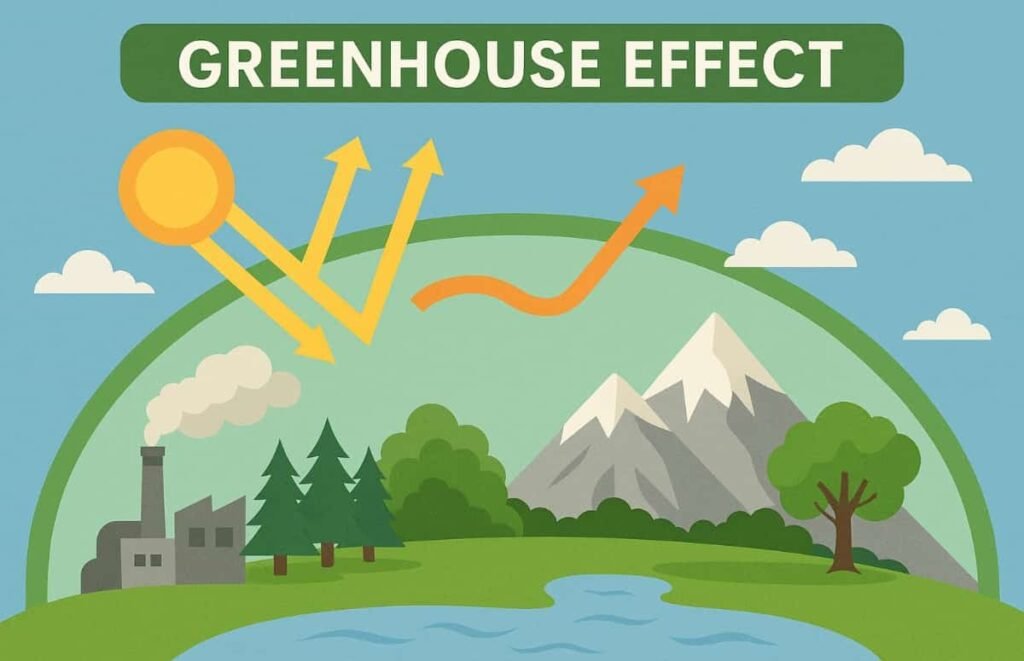Greenhouse Effect Easy Paragraph For SSC & HSC Exams

Greenhouse Effect Paragraph: 200 Words
The greenhouse effect is one of the most critical environmental issues of the 21st century. It refers to the process by which certain gases in the Earth’s atmosphere trap heat, preventing it from escaping into space. These gases include carbon dioxide (CO₂), methane (CH₄), nitrous oxide (N₂O), and water vapor. Without the greenhouse effect, the Earth’s average temperature would be around -18°C, making it impossible to sustain life.
However, due to excessive human activities such as burning fossil fuels, deforestation, and industrial emissions, the greenhouse effect has intensified. As a result, the Earth’s temperature is gradually rising a phenomenon known as global warming. This rise in temperature leads to melting polar ice, rising sea levels, and more frequent extreme weather conditions.
The greenhouse effect is essential in small amounts because it keeps our planet warm. But an increased greenhouse effect causes serious environmental threats. The excessive buildup of greenhouse gases creates an imbalance, leading to climate change and ecological disruptions.
To reduce the harmful impact of the greenhouse effect, we need to shift to renewable energy sources like solar and wind, plant more trees, reduce industrial pollution, and adopt eco-friendly lifestyles. Awareness and action can help protect our planet for future generations.
In conclusion, the greenhouse effect is both a natural necessity and a growing concern. Proper understanding and timely action are vital to managing this issue effectively and ensuring a sustainable environment.
Greenhouse Effect Paragraph: 400 Words
The greenhouse effect is a natural phenomenon that plays a significant role in maintaining the Earth’s climate and temperature. It occurs when greenhouse gases such as carbon dioxide (CO₂), methane (CH₄), water vapor, and nitrous oxide (N₂O) trap heat from the sun in the Earth’s atmosphere. This process prevents the heat from escaping back into space, thus warming the Earth and making it habitable for humans, animals, and plants.
Without the greenhouse effect, life on Earth would not be possible. The planet would be too cold to sustain agriculture, biodiversity, or the water cycle. Naturally, the greenhouse effect is a beneficial system, balancing heat and maintaining life-supporting conditions.
However, in recent decades, human activities have significantly increased the levels of greenhouse gases. The burning of fossil fuels like coal, oil, and gas for transportation, electricity, and industrial use releases enormous amounts of CO₂ into the atmosphere. Deforestation, agriculture, and waste management also contribute to the emission of greenhouse gases. As a result, the greenhouse effect has intensified unnaturally, leading to global warming.
Global warming, driven by the increased greenhouse effect, causes numerous environmental challenges. Ice caps and glaciers are melting at alarming rates, resulting in rising sea levels and coastal flooding. Extreme weather events like hurricanes, droughts, and wildfires are becoming more frequent and severe. Ecosystems are being disrupted, and many species face extinction due to changes in habitat and food availability.
The greenhouse effect also has economic and social impacts. Crop failures, water shortages, and health problems are increasing in many parts of the world. Poor and developing countries suffer the most, as they often lack the resources to adapt to climate-related issues.
To mitigate the negative effects of the greenhouse effect, governments, organizations, and individuals must work together. Using renewable energy sources such as solar, wind, and hydro can significantly reduce carbon emissions. Promoting energy efficiency, reforestation, sustainable farming, and responsible consumption are also crucial steps.
Educating the public about the greenhouse effect is another important measure. People must understand how their daily activities contribute to the problem and what they can do to help. Simple changes like reducing plastic use, cycling instead of driving, and conserving electricity can collectively make a big difference.
In summary, it is a vital but delicate system. While it helps sustain life, its uncontrolled rise poses severe risks to the environment and humanity. By taking timely and responsible actions, we can control its impact and ensure a healthier planet for current and future generations.
FAQ
It is the process where gases like carbon dioxide trap heat from the sun in Earth’s atmosphere, keeping the planet warm enough to support life.
It increases due to human activities like burning fossil fuels, deforestation, and industrial pollution, which release excess greenhouse gases into the atmosphere.
It contributes to rising global temperatures, leading to global warming, melting ice caps, rising sea levels, and extreme weather conditions.
It’s beneficial because it keeps Earth warm enough for life. However, too much of it causes environmental problems like global warming and climate instability.
We can help by using renewable energy, planting trees, recycling, and adopting eco-friendly lifestyles that reduce carbon emissions.